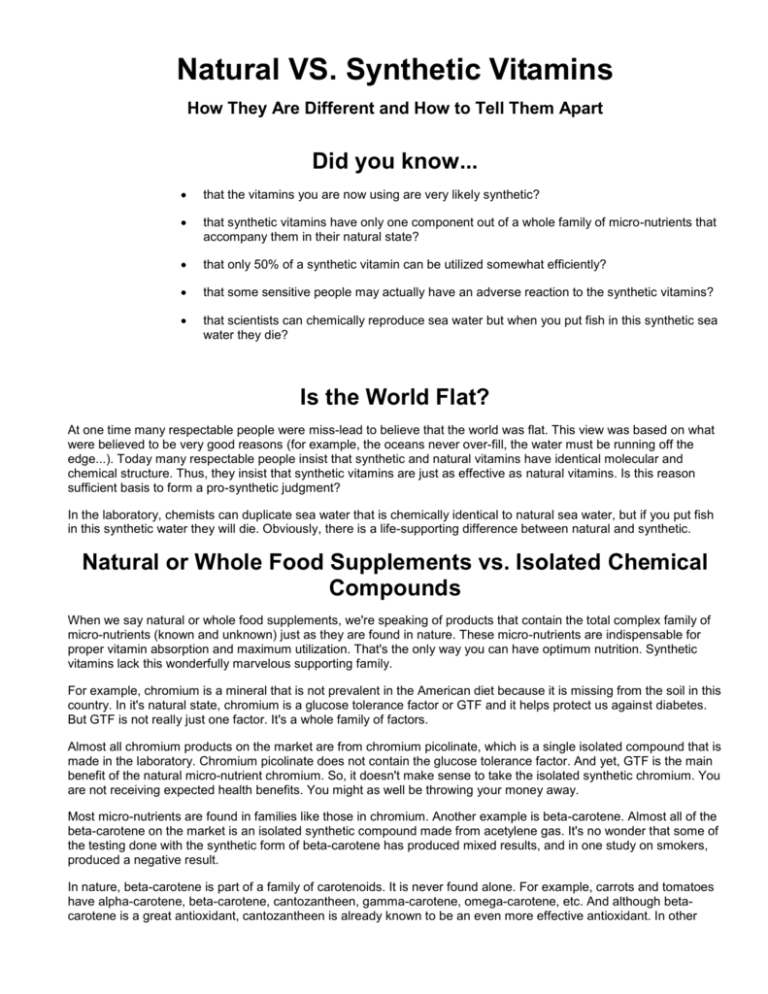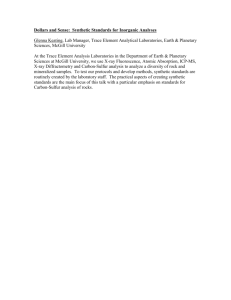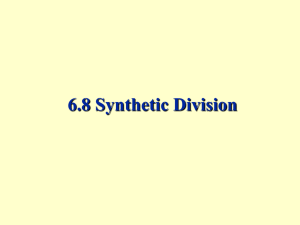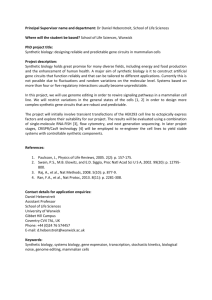Natural Vs. Synthetic Vitamins
advertisement

Natural VS. Synthetic Vitamins How They Are Different and How to Tell Them Apart Did you know... that the vitamins you are now using are very likely synthetic? that synthetic vitamins have only one component out of a whole family of micro-nutrients that accompany them in their natural state? that only 50% of a synthetic vitamin can be utilized somewhat efficiently? that some sensitive people may actually have an adverse reaction to the synthetic vitamins? that scientists can chemically reproduce sea water but when you put fish in this synthetic sea water they die? Is the World Flat? At one time many respectable people were miss-lead to believe that the world was flat. This view was based on what were believed to be very good reasons (for example, the oceans never over-fill, the water must be running off the edge...). Today many respectable people insist that synthetic and natural vitamins have identical molecular and chemical structure. Thus, they insist that synthetic vitamins are just as effective as natural vitamins. Is this reason sufficient basis to form a pro-synthetic judgment? In the laboratory, chemists can duplicate sea water that is chemically identical to natural sea water, but if you put fish in this synthetic water they will die. Obviously, there is a life-supporting difference between natural and synthetic. Natural or Whole Food Supplements vs. Isolated Chemical Compounds When we say natural or whole food supplements, we're speaking of products that contain the total complex family of micro-nutrients (known and unknown) just as they are found in nature. These micro-nutrients are indispensable for proper vitamin absorption and maximum utilization. That's the only way you can have optimum nutrition. Synthetic vitamins lack this wonderfully marvelous supporting family. For example, chromium is a mineral that is not prevalent in the American diet because it is missing from the soil in this country. In it's natural state, chromium is a glucose tolerance factor or GTF and it helps protect us against diabetes. But GTF is not really just one factor. It's a whole family of factors. Almost all chromium products on the market are from chromium picolinate, which is a single isolated compound that is made in the laboratory. Chromium picolinate does not contain the glucose tolerance factor. And yet, GTF is the main benefit of the natural micro-nutrient chromium. So, it doesn't make sense to take the isolated synthetic chromium. You are not receiving expected health benefits. You might as well be throwing your money away. Most micro-nutrients are found in families like those in chromium. Another example is beta-carotene. Almost all of the beta-carotene on the market is an isolated synthetic compound made from acetylene gas. It's no wonder that some of the testing done with the synthetic form of beta-carotene has produced mixed results, and in one study on smokers, produced a negative result. In nature, beta-carotene is part of a family of carotenoids. It is never found alone. For example, carrots and tomatoes have alpha-carotene, beta-carotene, cantozantheen, gamma-carotene, omega-carotene, etc. And although betacarotene is a great antioxidant, cantozantheen is already known to be an even more effective antioxidant. In other words, by isolating beta-carotene from its entire family of carotenoids the experts have taken away an even more beneficial antioxidant. The B vitamins are another good example. In 1925, there was only one known B vitamin. By 1975, ten other B family members had been discovered, bringing the total number of B factors to eleven. There's no telling how many more will be discovered by the year 2025. If you had taken an isolated synthetic B-1 compound in 1925, you would have missed all the rest of the B family factors, which all work together to counteract stress. But if you had used a whole food supplement like the Neo-Life B-Complex or Liver + C, you would have gotten all the known and unknown B vitamin factors, and that includes everything that won't be discovered until the year 2025! Like chromium, beta-carotene and B-complex, most nutrients are found in complex groups. Amino acids, vitamin E, trace minerals and vitamin C all come in families. Neo-Life keeps this family integrity intact with the most natural, the most researched, the most proven effective whole food supplements in the industry. So, with Neo-Life, you're not only getting the isolated vitamin, but you're also getting all of the other known and unknown factors, just as nature intended. And, you know it's not nice to try to fool Mother Nature! Biological Activity Reduced 50% Proponents of synthetic vitamins might claim natural and synthetic are equally effective; but when it comes to Vitamin E, that natural form is internationally recognized to be more biologically active than the synthetic form. The biological activity is reduced by 50%, even to 70% in synthetic form. Doubt has also been cast on other synthetic vitamins and their biological activity by Isobel Jennings of Cambridge University. "The synthetic vitamins may be identical with naturally occurring substances or closely related. The close relations, although useful in many ways, pose some problems in that they may have only a fraction, whether large or small, of the biological activity of the natural products ... Synthetic vitamins may perform some of the functions of their natural counterparts while being useless for others. But what may be more important is the fact that synthetic vitamins, prepared from chemicals instead of nature, are frequently less active biologically than their natural counterparts, thereby reducing any beneficial effect they may have." Polarized Light, A True Reflection The difference between synthetic and natural vitamins becomes apparent when viewing their response to a beam of polarized light. The light when passing through a natural vitamin will always bend to the right due to it's molecular rotation. Thus the letter "d" (representing "dextro" which means "right") often appears on labels. However, the same light ray when passing through a synthetic vitamin will split into two parts, one part bending to the right and the other to the left. Because the synthetic vitamin is half "dextro" (right) and half "levo" (left), the letters "dl" often appear on labels at the beginning of the synthetic name. A synthetic vitamin is like the image in a mirror. It looks like the real thing but doesn't function like the real thing. Half of it will work in the body and the other half won't work as well. Dr. Charles Schneider, Ph.D., professor of Chemistry, University of Cincinnati concluded wisely, "Get the vitamins that say natural. There is a difference. The "dl" (synthetic) will be cheaper, but if you could figure it out per energy unit or per use, the natural one will be cheaper." Which would you rather have, the food in the mirror ... or the real food? Safety Medical findings indicate that synthetic substances may cause reactions in chemically susceptible individuals. Interestingly, the same individuals can tolerate naturally derived vitamins. When is Natural REALLY Natural? Did you know that most vitamins on the market claiming to be natural only have to be 10% natural to make this claim! If you decide to spend your hard-earned money on natural, it is critically important you learn to read labels to assure receiving your money's worth. A product can even be 100% organic and not be natural at all. To be called organic a molecule need only have at least one carbon atom. This definition broadens the range from acceptable food sources of animal and plant tissues to raw materials including coal tar and wood pulp (yum!). Many synthetics are made from coal tar derivatives. That's the same stuff that causes throat cancer for tobacco smokers. Don't you think your body can tell the difference? Surely your cells can make a distinction between food and coal tar, just as a fish knows the difference between natural and synthetic sea water. Many so-called natural vitamins have synthetics added to increase potency, or to standardize the amount in a capsule or batch. In addition a salt form is added to increase stability of the nutrient (i.e. acetate, bitartrate, chloride, gluconate, hydrochloride, nitrate, succinate). These terms added to the vitamin name help you identify synthetics. Generally speaking, you can identify natural by reading the label and finding a listed "food" source such as citrus, yeast, fish, vegetable, etc. If a chemical is listed or the source is blank, it is synthetic. (See our How to Read Labels chart.) The synthetic vitamin dealers would like you to believe that there's no difference between natural and synthetic, because synthetic vitamins are much cheaper to make and mean much more profit for the company. They are not efficiently utilized in the body as natural supplements due to the "dl" factor and the lack of complete families which include all surrounding micro-nutrients. It's your choice! ASK YOURSELF WHY: Do I Need Supplements? ARE YOU... having all of the energy you need to enjoy life to it's fullest? listening to your body give you signs that you are giving it what it needs to run efficiently? thinking ahead and concerned about protecting your future health and well being? under stress from today's fast pace? wanting to protect yourself from the environmental pollution surrounding us? concerned about the possible genetic trends revealing themselves in your family's ongoing health history? Then your answer could be yes, I need a supplement. Did You Know... that possibly 95% of all diseases are degenerative? that scientific evidence links nutrition to disease prevention? that likely 80% of all cancer comes from environmental pollution (the air we breath, the water we drink, and the chemically tainted foods we eat)? that the average American consumes 6 pounds of artificial chemicals a year? that the housewife is the person most at risk from these dangers? that maybe 15% of all Americans are in vital good health? WHY CAN'T I GET WHAT I NEED FROM THE FOODS I EAT? The foods you eat are stripped of nutrients through refining and processing. The foods you eat are laden with fats, sugars, and salts, and devoid of other essential nutrients. A USDA government survey of 21,500 people found that not one single person consumed 100% of the U.S. RDA, from the foods they ate. Due to the time it takes fresh foods to get from the farm to your table, 57% or more of the nutritional value can be lost. The foods you eat can be harmful from the use of pesticides, fungicides, sulfites, and preservatives. Is There A Solution? YES, you could eat freshly picked, organic foods, grown in soil that has been re-mineralized, then served raw or slightly cooked, in a way that is as close to their natural form as possible. You would also need to eat whole grain breads/pastas made from flour ground fresh daily. However, few of us can spend our entire day hunting, gathering, and carefully preparing our food! Is There A More Practical Solution For Today's Lifestyle? YES, you can supplement your diet with the most natural, most organic supplements on the market. This is not an excuse for a poor diet, but supplements can definitely help. We want you to have an unbiased way to determine whether your vitamins are natural or synthetic. The following list, "How to Read Labels," will help you determine what you are paying for with your hard earned money. How to Read Labels Item: If source Given Is: It Is: Vitamin A Fish Oils Lemon Grass Acetate Palmitate If source not given Natural Co-Natural Synthetic Synthetic Synthetic Vitamin B-Complex Brewers Yeast If source not given Natural Synthetic Vitamin B1 (Thiamine) Yeast Thiamine Mononitrate Thiamine Hydrochloride Natural Synthetic Synthetic Vitamin B2 (Riboflavin) Yeast Riboflavin Natural Synthetic Pantothenic Acid Yeast, Rice Bran or Liver Calcium D-Pantothenate Natural Synthetic Vitamin B6 (Pyridoxine) Yeast Pyridoxine Hydrochloride Natural Synthetic Vitamin B12 Liver Micro-organism fermentation Cobalamin Concentrate Natural Co-Natural Co-Natural PABA Yeast - Para-aminobenzoic Acid Aminobenzoic Acid Natural Synthetic Folic Acid Yeast or Liver Pteroylglutamic Acid Natural Synthetic Inositol Soy Beans Reduced from Corn Natural Co-Natural Choline Soy Beans Choline Chloride Choline Bitartrate Natural Synthetic Synthetic Biotin Liver d-Biotin Natural Synthetic Niacin Yeast Niacinamide Niacin Natural Co-Natural Synthetic Vitamin C (Ascorbic Acid) Citrus, Rose Hips, Acerola Berries Ascorbic Acid If source not given Natural Synthetic Synthetic Vitamin D Fish Oils Irradiated Ergosteral (Yeast) Calciferol Natural Synthetic Synthetic Vitamin E Veg Oil, Wheat Germ Oil, or Mixed Tocopherols d-alpha tocopherol * dl-alpha tocopherol Natural Natural Synthetic Vitamin F Essential Fatty Acids Natural Vitamin K Alfalfa Menadione Natural Synthetic * The "dl" form of any supplement is synthetic.








